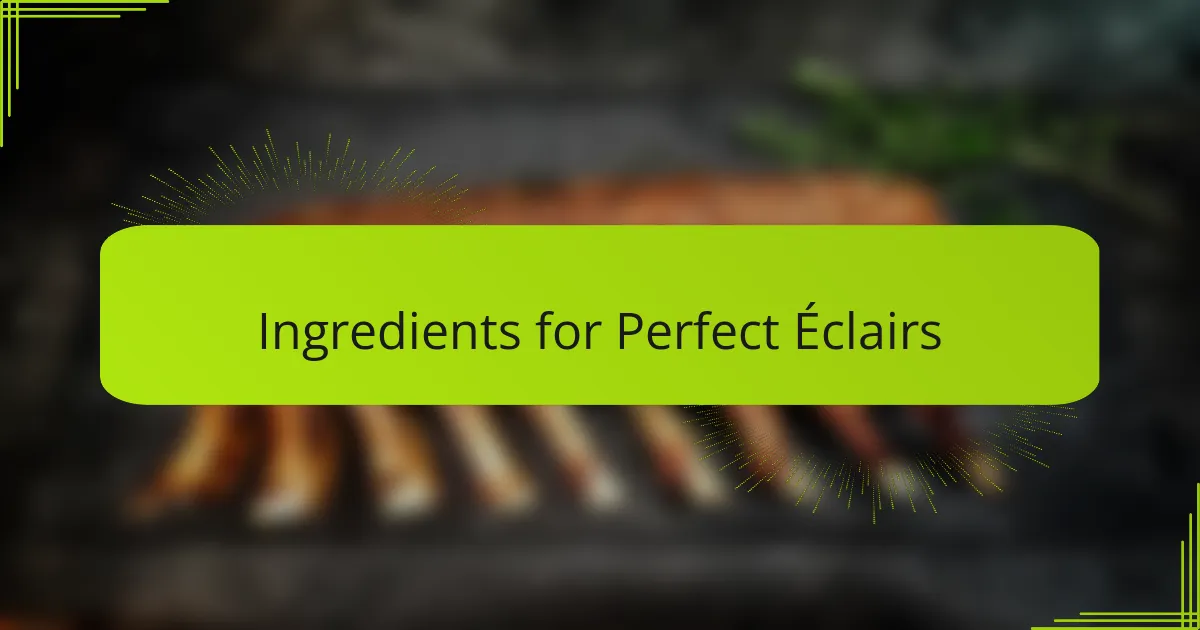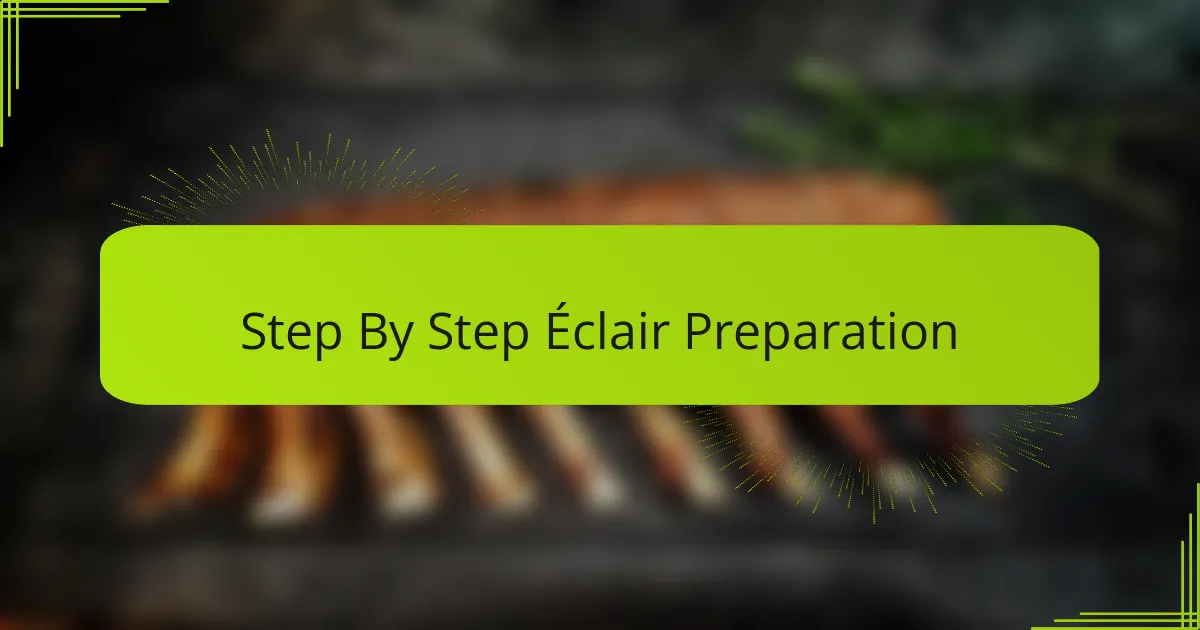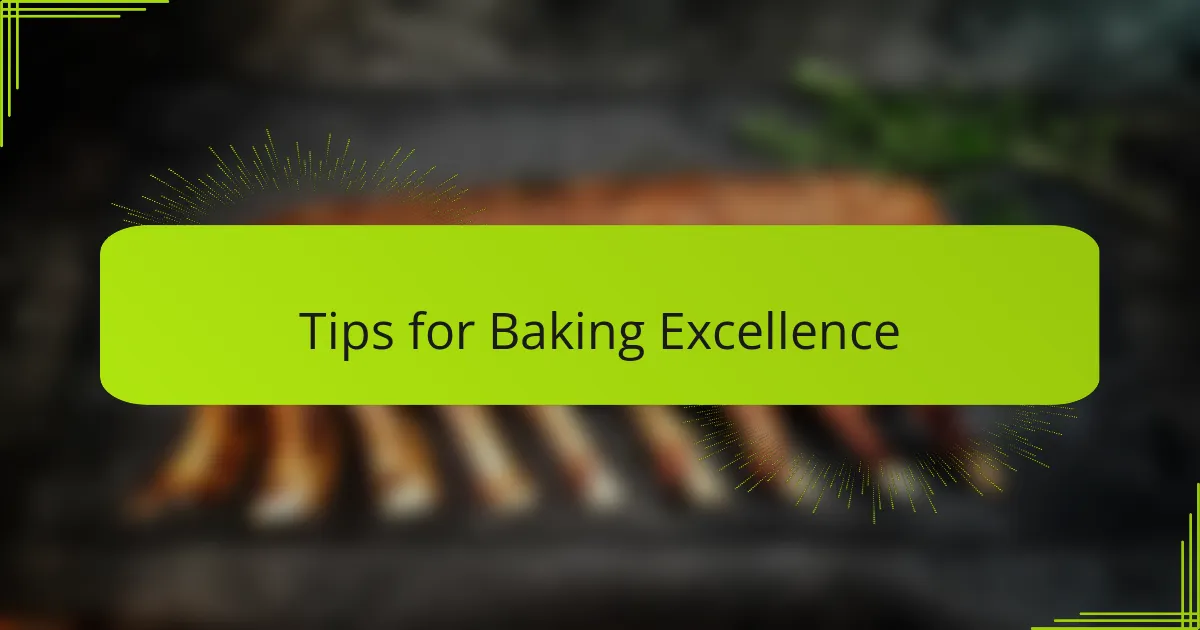Key takeaways
- Éclairs are made from choux pastry, which requires precise boiling and mixing techniques for the perfect texture.
- Filling with high-quality pastry cream and using quality ingredients greatly influences the overall flavor and experience.
- Oven management, including avoiding premature door openings and rotating trays, ensures even baking and puffiness.
- Decorating and experimenting with fillings allows for personalization, enhancing both appearance and taste.

What Are Éclairs Dessert Basics
Éclairs are classic French pastries made from choux dough, which is light and airy—yet sturdy enough to hold a rich filling. When I first encountered this delicate balance, I was surprised by how simple ingredients like butter, water, flour, and eggs could transform into such an elegant dessert.
Have you ever wondered what gives éclairs their signature crisp shell and soft interior? It’s all about the baking technique and dough preparation. I remember my early attempts where I paid close attention to the steam created in the oven—that’s what helps the dough puff up perfectly.
Filling éclairs traditionally involves pastry cream, a smooth custard that adds a velvety texture and sweetness. For me, mastering the cream was just as important as perfecting the dough because it’s the harmony of both that makes the éclair an unforgettable treat.

Essential Pastry Arts Techniques
One of the first techniques I had to master was making choux pastry, which relies heavily on the perfect balance of moisture and heat. It took a few tries for me to realize that the water and butter must come to a vigorous boil before adding the flour, creating a dough that’s just right—not too wet, not too dry. Have you ever thought how such a simple step can make or break the entire éclair?
Another key technique I learned was the art of mixing eggs into the dough. It’s not just about adding them all at once; instead, beating them in gradually until the mixture feels smooth and glossy is crucial. I used to rush this step, only to end up with a heavy dough that wouldn’t rise properly—something I don’t recommend if you want that iconic puffiness.
Of course, piping the dough onto the baking sheet is more than just a practical step—it’s where your flair comes through. I remember the nervous excitement of squeezing the dough into neat, even logs, trying to resist the urge to just dollop them randomly. Getting this right meant more even baking and that signature éclair shape, and honestly, it felt like I was shaping a little piece of art every time.

Ingredients for Perfect Éclairs
When I first gathered the ingredients for éclairs, I was amazed by how few and simple they were. Just butter, water, flour, eggs, and a pinch of salt—nothing fancy, yet each one plays a critical role. Have you ever noticed how using high-quality butter makes a difference? I sure did; it adds a richness that you can’t fake.
Flour choice also caught me off guard. I learned that using all-purpose flour works well, but a flour with moderate protein content gives the best structure for choux pastry. I remember trying a different kind and ending up with a dough that was too dense—definitely a valuable lesson. It’s these subtle details that transform a basic list of ingredients into the foundation of a perfect éclair.
Then there’s the filling and glaze—pastry cream and chocolate ganache require their own set of ingredients like milk, sugar, eggs, and good-quality chocolate. From my experience, skimping on the chocolate or using mascarpone instead of pastry cream changes the whole dessert’s character. So, I always remind myself: impeccable ingredients make all the difference in achieving that flawless balance between crisp shell and creamy center.

Step By Step Éclair Preparation
Getting started with éclair preparation is all about patience and attention to detail. I found that beginning with perfectly boiled water and butter, then swiftly mixing in flour, sets the stage for success. Have you ever noticed how that first dough reacts—forming a smooth ball that’s just dry enough to hold shape? That moment gave me confidence every time.
Piping the dough is where things got exciting for me. Using a sturdy piping bag, I carefully squeezed out even, elongated shapes onto the baking tray. It’s funny how something as simple as controlling the pressure can make a difference between a misshapen puff and the classic slender éclair. Watching those little logs rise and turn golden in the oven became one of my favorite parts of the process.
Filling the cooled shells with pastry cream felt like breathing life into the éclairs. I quickly learned that using a piping bag fitted with a small nozzle allowed me to fill every nook without cracking the delicate pastry. Have you ever felt that sense of satisfaction when you bite into an éclair, and the creamy center bursts out just right? That’s the magic of nailing each step patiently and precisely.

Tips for Baking Excellence
I quickly realized that controlling the oven temperature was crucial for baking éclairs to perfection. Have you ever opened the oven door too soon and watched your beauties collapse? Trust me, resisting that urge pays off—the steam inside is what makes those delicate shells puff just right.
Another tip I swear by is rotating the baking tray halfway through baking. It might seem minor, but in my experience, it ensures even browning and crispness. I remember the disappointment of uneven éclairs before I made this a habit—it’s those little adjustments that make all the difference.
Lastly, patience after baking is key. Letting the éclairs cool completely before filling them prevents sogginess. I used to rush this part and ended up with soggy bottoms, which was a big letdown. Now, I enjoy that calming wait, knowing it’s setting the stage for a perfectly textured bite.

Decorating and Filling Ideas
When it came to filling éclairs, I found that the possibilities stretch far beyond traditional pastry cream. Have you ever tried a café au lait-flavored cream or a tangy lemon curd? Adding unexpected flavors not only excites the palate but also gave me the thrill of making each éclair uniquely mine. It’s like handing over a blank canvas and discovering new colors every time.
Decorating éclairs became a whole new adventure once I started experimenting with glazes and toppings. A glossy chocolate ganache always feels like the classic move, but I loved brushing on a shiny caramel glaze or dusting with crushed pistachios for texture. Sometimes, I even piped delicate whipped cream rosettes, and let me tell you, seeing those finished éclairs felt like a sweet victory.
Do you prefer your éclairs sleek and minimal or playfully adorned? For me, simplicity often wins, but I can’t resist a drizzle of bright fruit coulis or a sprinkle of edible gold leaf when I want to impress. These finishing touches are what transform humble pastries into eye-catching desserts that invite compliments—and I learned that it’s all about balancing elegance with personal flair.

My Éclair Making Experience
My first hands-on experience making éclairs was both thrilling and humbling. I remember standing at the counter, nervously mixing the dough as I recalled the precise boiling of water and butter—such a small step, yet one I knew could make or break the entire batch. Have you ever felt that mixture’s texture change right before your eyes? That moment gave me a strange mix of hope and doubt, but also excitement that I was on the right path.
As I piped the dough onto the tray, butterflies hit my stomach. Could I really shape these delicate logs evenly enough for them to rise perfectly? It was like crafting a miniature sculpture where every squeeze counted. Watching them bake and puff up in the oven was pure magic; each golden éclair felt like a small victory that made all the careful steps worth it.
Filling the cooled shells was another lesson in patience and precision. Using a piping bag to inject the creamy custard without cracking the pastry tested my steady hand more than I expected. When I finally took that first bite and the smooth cream burst out inside the crisp shell, I felt a proud satisfaction that can only come from mastering a challenging recipe—and suddenly, all the trial and errors made perfect sense.




